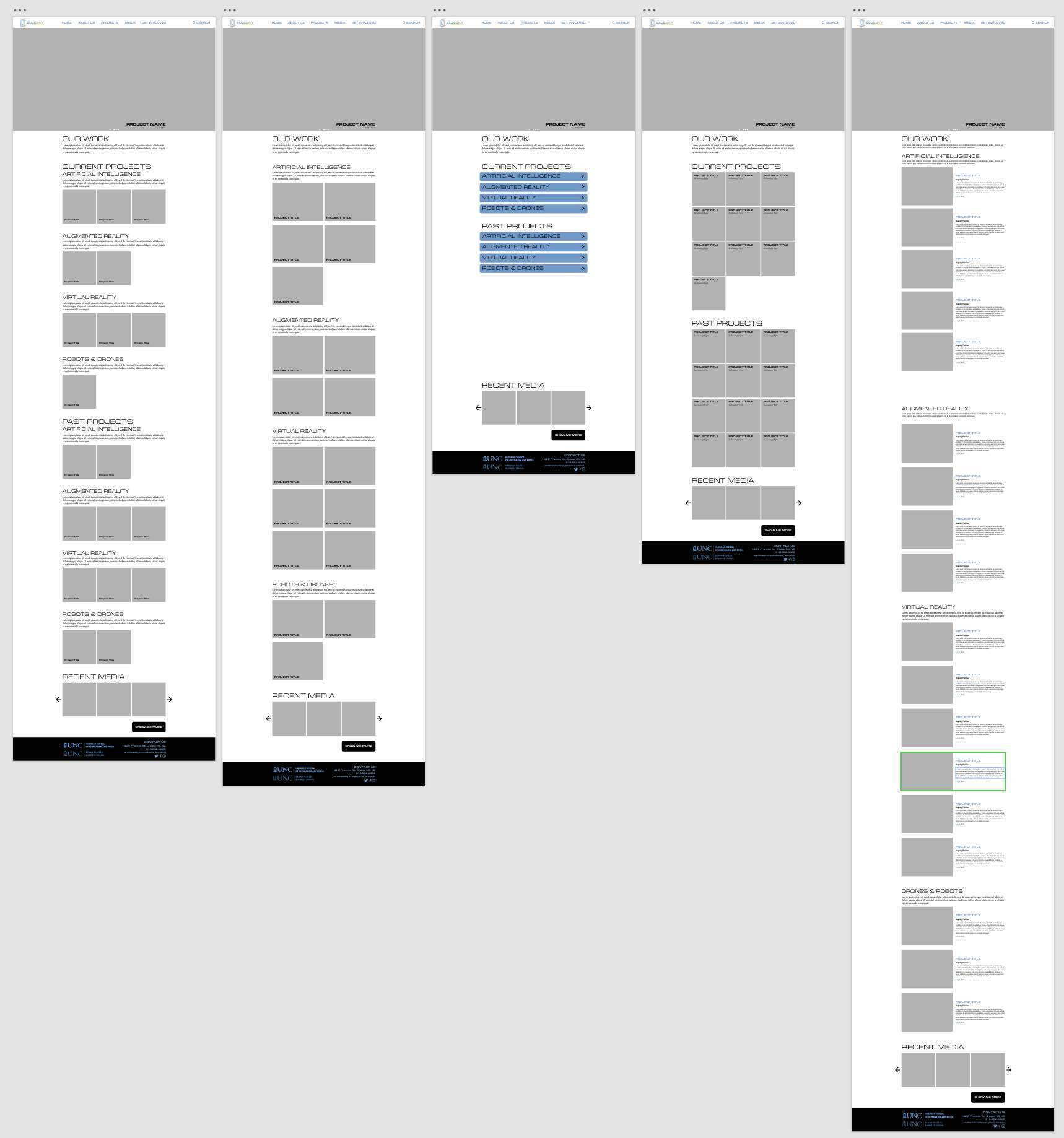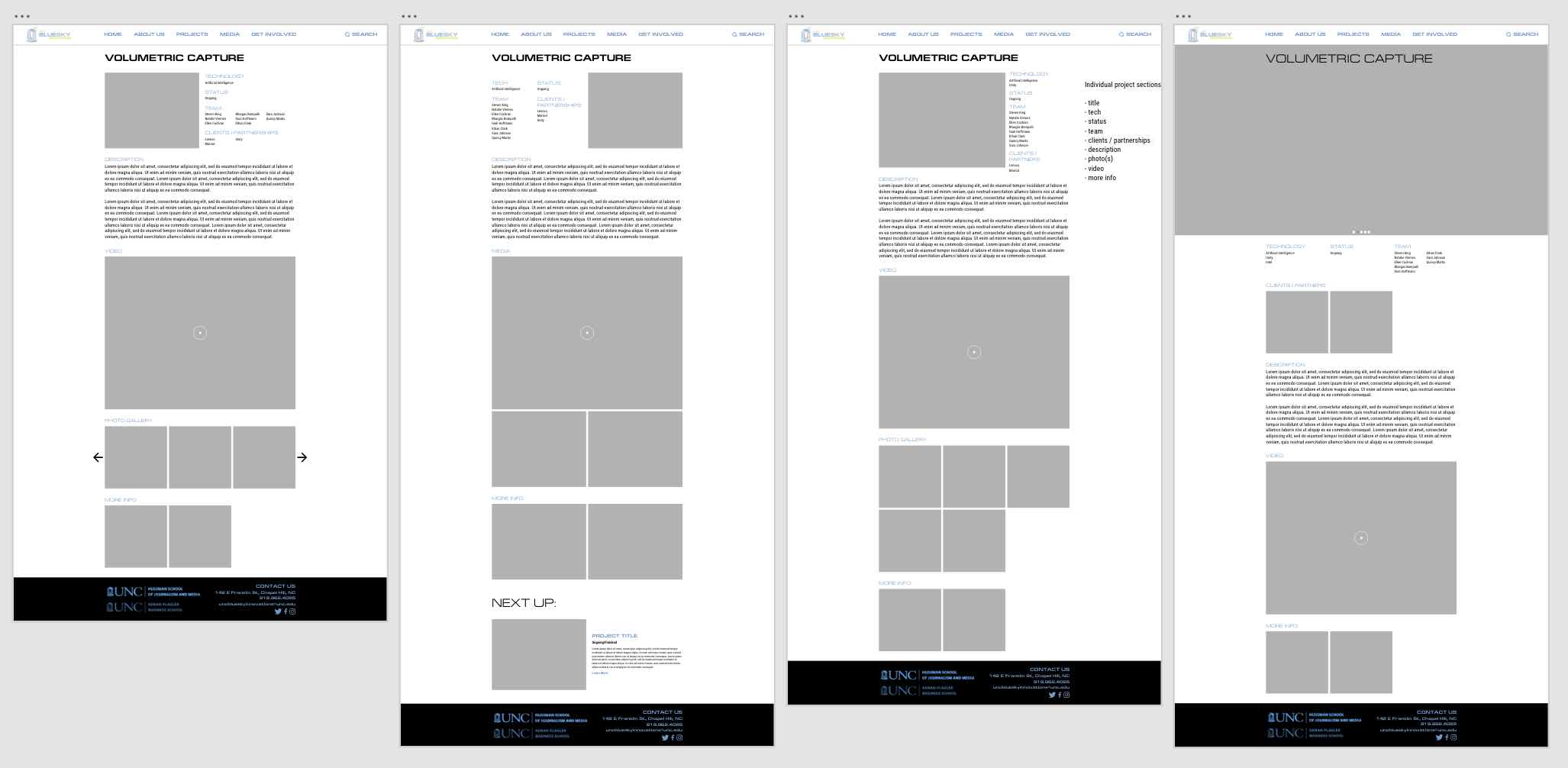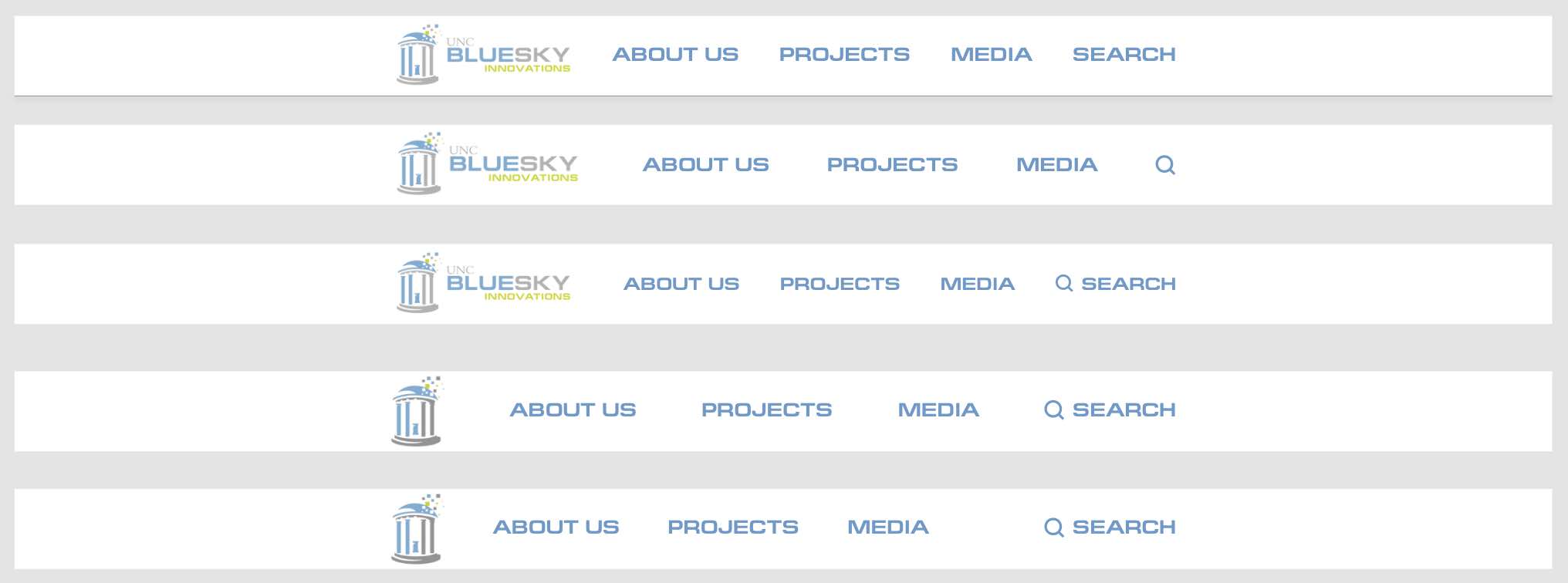Blue Sky Innovations Website Redesign
Skills: UI Design, UX Research, Creative Direction, Content Strategy
Tools: Adobe XD
Created in summer 2023 for UNC’s Blue Sky Innovations
As a Design & Development Fellow, I analyzed the company’s website and identified key issues, including:
- Disorganized Navigation & Sitemap – Multiple home links, no search functionality, unclear headings, and missing links to key pages hindered user navigation.
- Inconsistent Design Elements – Margins, padding, layout alignments, text sizes, fonts, buttons, colors, and hover effects varied significantly, detracting from visual cohesion and professionalism.
- Outdated Aesthetic – The layout, imagery, and excessive white space lacked visual appeal, failed to engage users, and did not align with competitors’ modern designs or the target audience’s expectations.
- Unclear & Outdated Project Pages – VR and AR were grouped into one category with minimal descriptions and few visuals, making projects feel secondary rather than a focal point.
- Lack of Responsiveness – The website did not adapt effectively to different screen sizes, leading to usability issues on mobile and tablet devices.
- Cluttered & Ineffective Footer – Five rows of content created visual clutter, making it difficult to distinguish the footer from the main page content.
Noting misalignments between the site’s branding and the company’s work, I compiled a detailed report outlining areas for improvement. I pitched a redesign to the Creative Team Lead, Lab Manager, and CEO, who approved the proposal and tasked me with creating mockups. Using the company’s style guide and competitive research, I designed wireframes and a full-scale prototype, refining it through feedback from the Creative Team Lead.
Wireframe Iterations
For the initial stage, I focused on the Home, Projects, and an individual project example pages, as well as the navbar, because I thought needed the most changes. Click on the following image to be taken to the Adobe XD file.
Home
In the initial phase, I approached the Home page as a comprehensive introduction to the site’s content and purpose. I strategically structured it to highlight key areas, including an overview of who we are, featured work, staff and client calls-to-action, recent social media activity, upcoming events, client and team highlights, and a contact form. The goal was to create a welcoming, informative landing experience that guided users seamlessly to deeper site content.
All Projects
During the site audit, I identified a critical UX gap: while the navigation bar included a “Projects” dropdown, there was no dedicated page consolidating all projects in one place. To address this, I focused on designing an intuitive, visually engaging layout for showcasing our full project library. I explored multiple organization methods—including sorting by category, creation/modification date, or a combination of both—to enhance discoverability. I also proposed several layout and interaction styles, such as grid-based thumbnails (square or rectangular) with hover-over descriptions, accordion views, and two-column layouts pairing images with descriptive text.
Click the image below to be taken to the respective Adobe XD file.
Individual Project (Volumetric Capture)
During the site audit, I identified several key issues with the individual project pages: descriptions were often unclear or outdated, visual content was minimal, and there was no intuitive way to navigate between projects without returning to the category overview. To address these challenges, I developed wireframes that explored how to better integrate visuals and related content—such as image galleries or embedded media—while maintaining a strong focus on clear, informative text descriptions.
Click the image below to be taken to the respective Adobe XD file.
Navbar
The final—and arguably most impactful—stage of the wireframing process was reimagining the site’s navigation bar. The existing navbar had several usability issues: duplicate “Home” links (via both the logo and a labeled button), no search functionality, a non-functional “Projects” dropdown, and ambiguous section headings. Collaborating closely with the Creative Team Lead, I iterated on several versions, refining what content truly needed to be included in the main navigation and how best to group more miscellaneous items under intuitive dropdowns. The goal was to create a streamlined, user-friendly navigation experience that reflected both site structure and user priorities.
During this process, I discovered that our Wix site restricted content to the central 50% of the page, requiring a more compact navigation layout. This limitation made it even more important to be intentional about what content was included and how it was categorized.
After reviewing several iterations, we ultimately chose option four, shown below. This version featured a clean, well-organized structure: the logo served as the “Home” link, followed by an “About Us” dropdown containing “DEI,” “Team,” “Events,” and “Contact.” The “Projects” menu included our four main project categories, while the “Media” dropdown housed links to the Blog, Videos, and Photos. We also added a search button for improved usability. This streamlined navigation bar was the version I implemented in the final mockup.
Final Mockup
Click on the following image to be taken to the Adobe XD file.
Overview
My final mockup—while slightly slow due to platform limitations—is fully functional and presents a reimagined vision for the site’s purpose and layout. Rather than treating the Home page as a basic introduction, I redesigned it to showcase the breadth and quality of our work. This included not only our in-house projects but also links to supplementary content such as blogs, explanatory videos, social media posts, and press coverage. Because the primary goal of the site was to generate excitement around our work—not necessarily to advertise services or attract new hires—this featured content was placed prominently at the top of the page.
Calls to action (CTAs) were reworked to be more intentional and better aligned with user behavior. For example, social media links were embedded after showcasing content pulled directly from those platforms, creating a more natural and compelling incentive for users to explore further.
Modernized Visual Design & Content Strategy
To modernize the look and ensure cohesive design across the site, each primary page included a full-width splash image carousel. These large, high-quality visuals served to highlight our work right away, reducing the need for users to dig through inner pages or external social links to understand our impact.
Project category pages were organized with “Current” projects appearing first, followed by “Past” projects. I used a two-column layout pairing images with short descriptions, allowing users to quickly scan and engage without needing to hover or click. On individual project pages, I broke from this format to avoid redundancy and better utilize space. Each project detail page began with a large splash image or carousel to immediately capture attention, followed by detailed descriptions and supporting content—such as videos, blog posts, or social embeds.
Another major addition was the creation of a dedicated Events page. It included a calendar view of the current month’s events, followed by a list of upcoming dates with specific details, all designed to boost user engagement and generate excitement around both virtual and in-person activities.
Site Structure & Page Types
- Home
- About Us
- DEI
- Team
- Staff Member Bio
- Events
- Projects
- Artificial Intelligence
- Volumetric Capture
- Artificial Intelligence
- Media
- Photos
- Photo Event
- Blog and Videos would link directly to the company’s Medium and YouTube accounts, respectively
- I did not build out Contact because the Creative Team Lead was unsure the page was necessary
- Photos
Conclusion
Unfortunately, because my internship ended shortly after I proposed these mockups, I did not have a chance to implement the redesign. In fact, a few months after I left, Blue Sky Innovations rebranded as Blue Sky Robotics and launched an entirely new website, so Innovations was never updated.
While there are aspects of the visual design I would now refine further—such as approaching the layout with a mobile-first mindset—especially with the perspective gained over the past two years, this project still marked a meaningful improvement in both the site’s structure and usability. One of the most impactful changes was the reorganization of the sitemap and enhanced navigation, which significantly improved the user experience.



